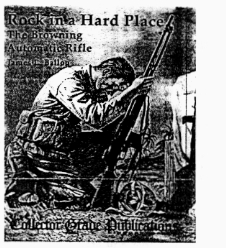Rock in a Hard Place
The Browning Automatic Rifle US $79.95 List Written by a well-known professional firearms journalist and combat shooting instructor, Rock in a Hard Place Is the first-ever In-depth study of one of the most popular small arms in U.S. history - the Browning Automatic Rifle. The legendary BAR began as a single hand-made, closed-bolt-firing model with an open-top receiver, designed by John M. Browning and machined to the great inventor’s specifications by his half-brother, Jonathan Edmund Browning, In the Browning Brothers’ Ogden, Utah, shop. Right from the outset, John M. Browning’s “Automatic Machine Rifle” was an instant success. Despite strong criticism from such as ex-president Theodore Roosevelt, who decried the Browning as a “paper gun”, the Model 1918 BAR was quickly adopted and put into production at three facilities during World War I. Colt’s were awarded the first contract, but Winchester got there “first with the most”, followed in production volume by Marlin-Rockwell. Rightly or wrongly, however, the military high command decided to withhold the BAR from combat until the very last weeks of the war. Over 102,000 Ml 918 Browning Automatic Rifles were produced during this period. At war’s end the rights to the BAR reverted to Colt’s, the licensees of John Browning’s patent, and several models of the Colt commercial “Automatic Machine Rifle” were produced between the wars. Over 5,000 were sold abroad, and several hundred more were made for domestic law enforcement use. The finest of these was perhaps the Colt “Monitor” which, with its ultra-short 18” barrel and distinctive Cutts compensator, became the first official fighting rifle of the Federal Bureau of Investigation (FBI). Numerous military trials were carried out with modified Ml 918 BARs during the Interwar twenties and thirties, resulting In the short-lived adoption of the heavy-barreled Model 1922 Cavalry Machine Rifle, about 500 of which were made up, and also small numbers of the elusive M1918A1, adopted In 1937. After World War II broke out in Europe In 1939, existing stocks of WWI-era BARs were first “modernized” into the newly adopted M1918A2, with Its muzzle-mounted bipod and controversial rate reducing mechanism. After Pearl Harbor, new series production of the M1918A2 was instigated at two facilities, New England Small Arms Corporation, where a total of 168,363 BARs were made, and IBM, where a further 20,017 were manufactured. In the 1 950s, the Korean conflict prompted the final production run of 61,000 more M1918A2 BARs, by the Royal Typewriter Co. The BAR remained one of the most respected weapons in the U.S. arsenal for over four decades, proving time and time again that, when the fighting got heavy, the BAR was truly a “Rock in a Hard Place”. Offshore, interest ran high in Britain and France after WWI, and substantial licensed production of BAR copies and clones took place at Fabrique Nationale (FN) in Belgium, and in Poland and Sweden. W hole, well-illustrated chapters are also devoted to the technical side of the story: “How the BAR Works”; “A Treatise on BAR Parts”; “Troubleshooting the BAR”; and “Accessories and Ancillaries”. The final section, “The Immortal BAR”, contains chapters titled “The ‘Aftermarket’ BAR”, and. “That’s J Entertainment”. The book ends with .a Bibliography, and a comprehensive Index. TO ORDER THIS BOOK CONTACT JIM BALLOU AT 128 WOODLAWN ST., LYNN, MASS 01904 (617-592-3994). OR B/H DIST PO BOX 8710, NEWARK, OH 430755 (740-345-9777). |
|
